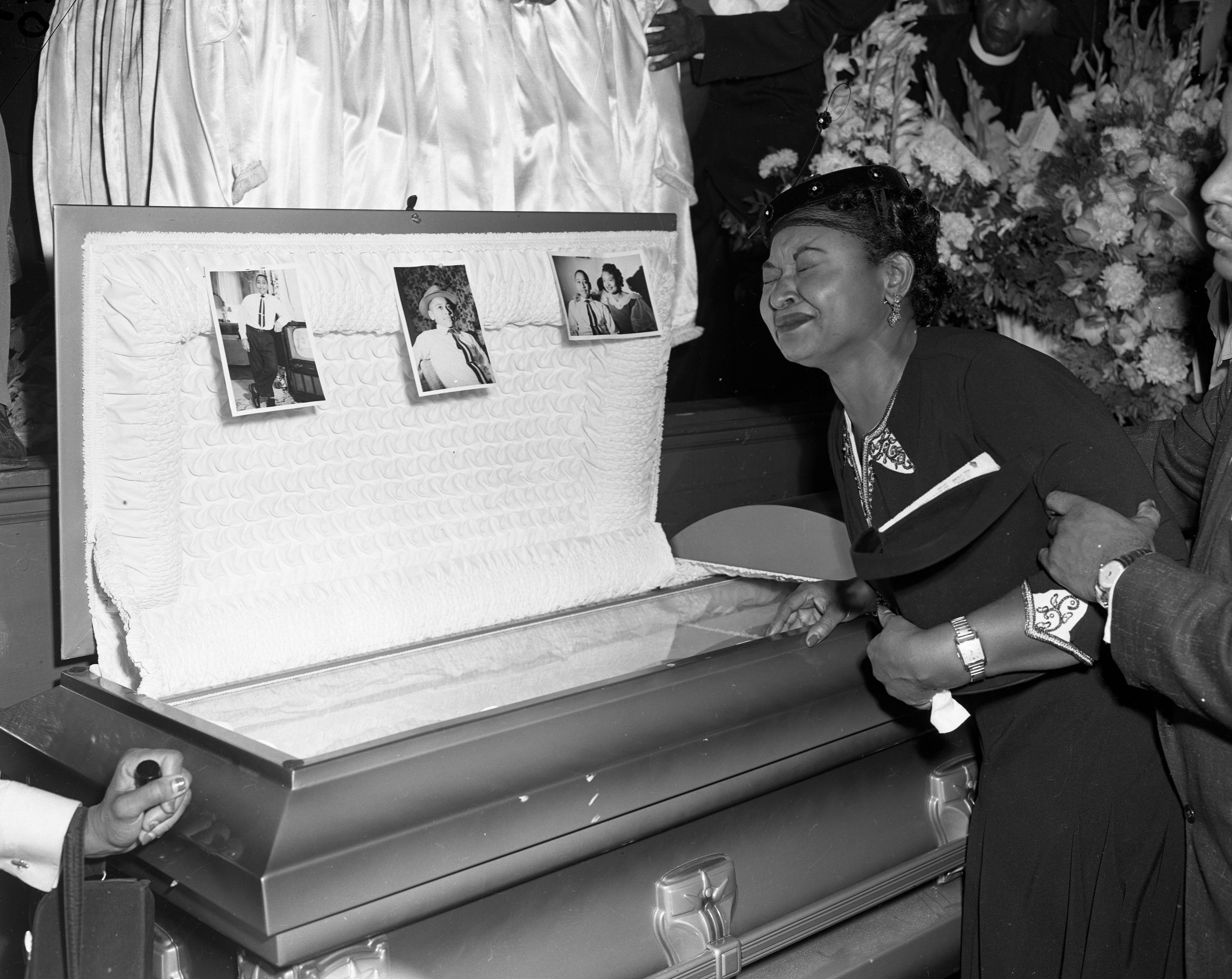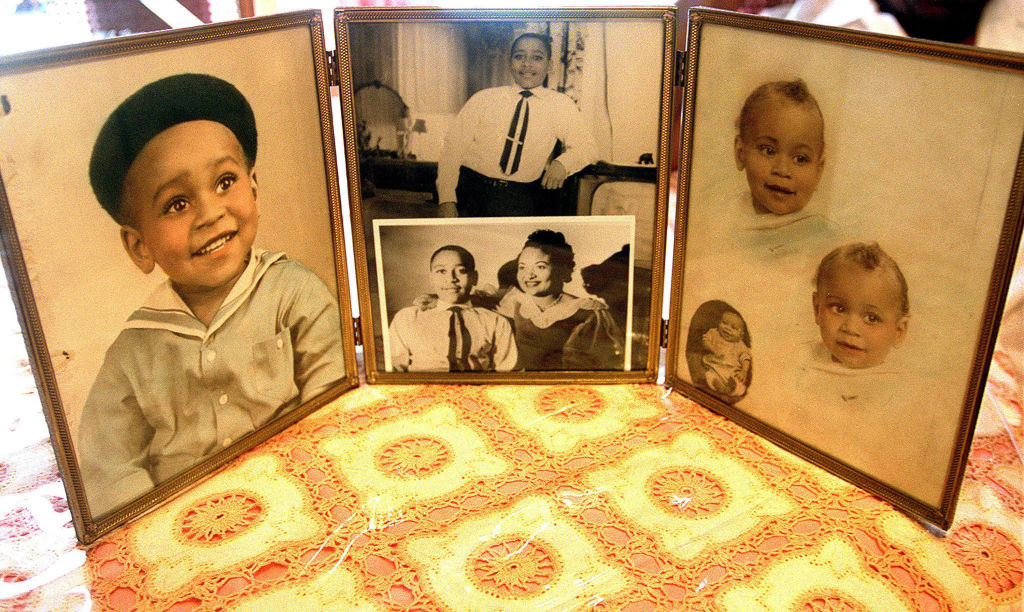For more rich textural details of the life of Emmett Till, see: Mamie Till-Mobley and Christopher Benson, Death of Innocence: The Story of the Hate Crime That Changed America (One World, 2003) and Adeel Hassan, He Had a Life Before Death’: Remembering Emmett Till for the Child He Was, New York Times, September 5, 2021.
When Dana Schutz’s painting Open Casket (2016) was shown at the Whitney Biennial, it split the art world along familiar fault lines. The artist’s abstracted depiction of Emmett Till’s corpse—modeled after David Jackson’s searing 1955 photographs for Jet magazine—reignited Mamie Till-Mobley’s demand to “Let the world see what I’ve seen,” while exposing who gets to control that seeing. Critics called it profiteering: a white artist converting Black trauma into cultural capital. Defenders cried censorship. But beneath the shouting match lay a quieter, more insidious cruelty: the way the debate flattened Emmett into an argument, leaving the boy himself—the one who polished his father’s signet ring nightly, who crowed “JELL-O!” as his first word—buried under the weight of his own symbolism. Here was the paradox laid bare: memorials often erase the very lives they claim to honor. Is it even possible to remember without replicating violence? The question haunts—not just how we remember, but whether we can. Open Casket made the dilemma visceral: a boy’s body became terrain for our wars over meaning.

The debate was inescapable—especially among those of us trained to dissect art’s relationship to power. It spilled out of galleries and into graduate seminars and protests, onto social media and daytime television. Fluency in theory didn’t prevent Emmett’s story from hardening into a rhetorical tool. The more we invoked his name, the less he resembled the child who’d begged for a motorbike, who packed his suitcase three days early in anticipation of his visit to his cousins. We sanded down his humanity to fit our arguments: away went the frayed elbows of Emmett’s beloved purple sweater, the stutter that bloomed into laughter. We sanded until only the outline remained: a silhouette where a boy had been. A life became a lodestone. Grief, polished smooth by repetition, until all that remained were his final, horrific moments.
The debate around Open Casket represents a fraught kind of remembrance—one that treats the past not as settled history, but as an open wound still shaping our present. Loss can force reckoning; it shows us where we’ve failed and demands that we do better. But in this necessary confrontation, we risk repeating the violence of reduction. We are asked to remember how Emmett died, not who he was: the boy who loved knock-knock jokes, who struggled to recall the second “ssi” in writing “Mississippi.” The very act of memorial becomes another erasure.
Museums have anchored Emmett’s memory in physical remnants: his original casket at the National Museum of African American History and Culture, the bullet-riddled historical marker from the riverbank where his body was pulled from the Tallahatchie now at the National Museum of American History. These objects force us to confront brutality, yet they also risk replicating the same reduction they seek to combat. The casket shows what was done to Emmett; the bullet holes in the marker testify to ongoing hatred. Similarly, our debates can pierce memory itself, leaving the boy behind.

The casket is not Emmett. The marker is not Emmett. They are evidence of crimes and resistance, but not containers for a life. We preserve the wounds while the child—the whole, laughing, bubble-gum-chewing, breath-fogging-the-train-windows child—slips through the holes we've created in remembering him.
It’s easy to reduce historical figures to the singular moments that made them vital cultural, social, and political cornerstones—victory, anguish, activism, and death, patterns of behavior we retroactively deem significant. After all, that’s what makes the traditional monument world go round: distilled moments of what we construct as pinnacles of significance. But it’s harder to remember that these figures brushed their teeth, preferred butter pecan to chocolate ice cream, and smelled of a certain brand of laundry soap, that they knew what it felt like to stand barefoot in the grass and to pack a suitcase in hopes of a new adventure. They lived full lives, only fragments of which intersected with the public’s gaze. For some, that intersection came through violent rupture—a collision that should never have been.
These are names we should only encounter scrawled on math tests, doctor’s office forms, and birthday cards—the quiet archaeology of ordinary lives, not the chiseled certainty of monuments. But the reality is that many of these lives were never allowed to remain in the ordinary; they were thrust into the public consciousness by violence, their stories crystallized by tragedy until their humanity refracts into something harder, sharper—meant to cut, not comfort.
Historical objects—Emmett’s casket, the bullet-scarred marker—anchor us to memory’s brutal physics: the weight of a body, the torque of a bullet. They testify. But testimony is not resurrection. The casket cannot show us how Emmett’s tongue poked between his teeth in concentration, nor how his voice cracked when he told riddles. The marker’s 317 holes sing of violence, but not the boy’s off-key scatting—nor can they recall how his handwriting sloped when he practiced his father’s signature, or how he insisted “Febuary” needed only one “r”—a mistake his cousins teased, then treasured.
Art, when done with care, might come closer. Not Schutz’s Open Casket, which rendered trauma as material for the gallery’s gaze—but works like Lisa Whittington’s How She Sent Him and How She Got Him Back (2021), where the layered brushstrokes reconstruct the vibrancy of a boy who darned his own socks and dreamed of jazz solos alongside the terrible ruin of what was done to him—a work that captures both his life and the devastating tragedy of his death. This is the difference between art that mines pain and art that restores personhood. One reduces history to spectacle; the other forces us to stand in that impossible space where a child’s fishing badge still gleams new even as the river takes him—and asks: what was lost when this life became a symbol? Like a flower pressed between glass, his life was flattened to a specimen: fragile, archival, stripped of scent and season.

Remembering always carries risk. The casket, the bullet-scarred marker—they let us hold brutality at arm’s length, study it like archaeologists. But archaeology cannot resurrect what matters most: the living richness of Emmett himself. The terror is this: the same systems that turned his death into evidence now reduce his life to a footnote. Some would argue this trade has purpose, that focusing on objects, on the enduring machinery of racial violence, clears space for political reckoning. But when we excise a boy’s laughter, his frayed sweater, we commit another kind of erasure. True remembrance sits with this unbearable equation: we will always fail to capture the full radiance of a life. Nickels saved for the ice cream truck on sweltering August days, the warm reassurance of Emmett’s arms around his mother’s waist, the myriad details that Mamie Till-Mobley was able to squirrel away in history’s pockets—these fragments must stand in for a constellation we can never fully map.
As we remember Emmett Till, we must tread carefully. But what does care demand? The casket forces us to confront what was done. The marker proves that violence endures. The debate around Open Casket exposes our relentless hunger to claim the story—to turn grief into discourse. The casket, the holes, the words are not Emmett. He remains the boy who counted sleeps till Mississippi, who whispered riddles in the dark. True remembrance refuses the choice between mourning the child and fighting the systems that killed him—it demands we do both, letting our grief for one fuel our rage against the other. Not archaeology, but alchemy: letting grief unsettle history’s foundations, then rebuilding them.
